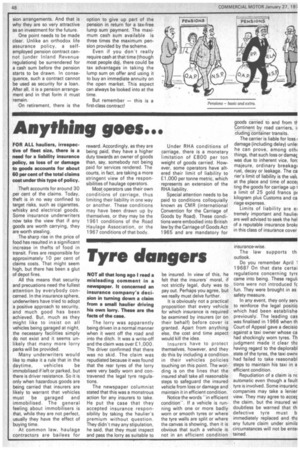Tyre dangers
Page 50

If you've noticed an error in this article please click here to report it so we can fix it.
NOT all that long ago I read a misleading comment in a newspaper. It concerned an insurance company's decision in turning down a claim from a small haulier driving his own lorry. These are the facts of the case.
The lorry was apparently being driven in a normal manner when it went off the road and into the ditch. It was a write-off and the claim was over £1 ,000, The driver confirmed that there was no skid. The claim was repudiated because it was found that the rear tyres of the lorry were very badly worn and contravened the legal tyre regulations.
The newspaper columnist stated that this was a monstrous action for any insurers to take. He put the case that they accepted insurance responsibility by taking the haulier's premium without question. They didn't may any stipulation, he said, that they must inspect and pass the lorry as suitable to be insured. In view of this, he felt that the insurers' moral, if not strictly legal, duty was to pay out. Perhaps you agree, but we really must delve further.
It is obviously not a practical proposition that every vehicle for which insurance is required be examined by insurers (or on their behalf) before cover is granted. Apart from anything else, the cost and time aspect would kill the idea.
Insurers have to protect themselves, however, and they do this by including a condition in their vehicles policies touching on this point. The wording is on the lines that the insured shall take all reasonable steps to safeguard the insured vehicle from loss or damage and maintain it in efficient condition.
Notice the words -in efficient condition-. If a vehicle is running with one or more badly worn or smooth tyres or where the tyre walls are split or where the canvas is showing, then it is obvious that such a vehicle is not in an efficient condition
insurance-wise.
The law supports th outlook.
Do you remember April 1 1968? On that date certai regulations concerning tyrE came into being. These reguli tions were not introduced fc fun, They were brought in as safety measure.
In any event, they only seo.i to reinforce the legal positio which had been este blishe previously. The leading cas was finalised in 1966 when th Court of Appeal gave a decisio against a taxi owner whose ca had shockingly worn tyres. Th judgment made it clear the having regard to the deplorabl state of the tyres, the taxi own( had failed to take reasonabl steps to maintain his taxi in a efficient condition.
Repudiation of a claim is ric automatic even though a fault tyre is involved. Some insuranc companies may take a lenier view. They may agree to accer the claim, but the insured wi doubtless be warned that th defective tyre must b immediately replaced and thE any future claim under simile circumstances will not be entel tamed.




















































































































